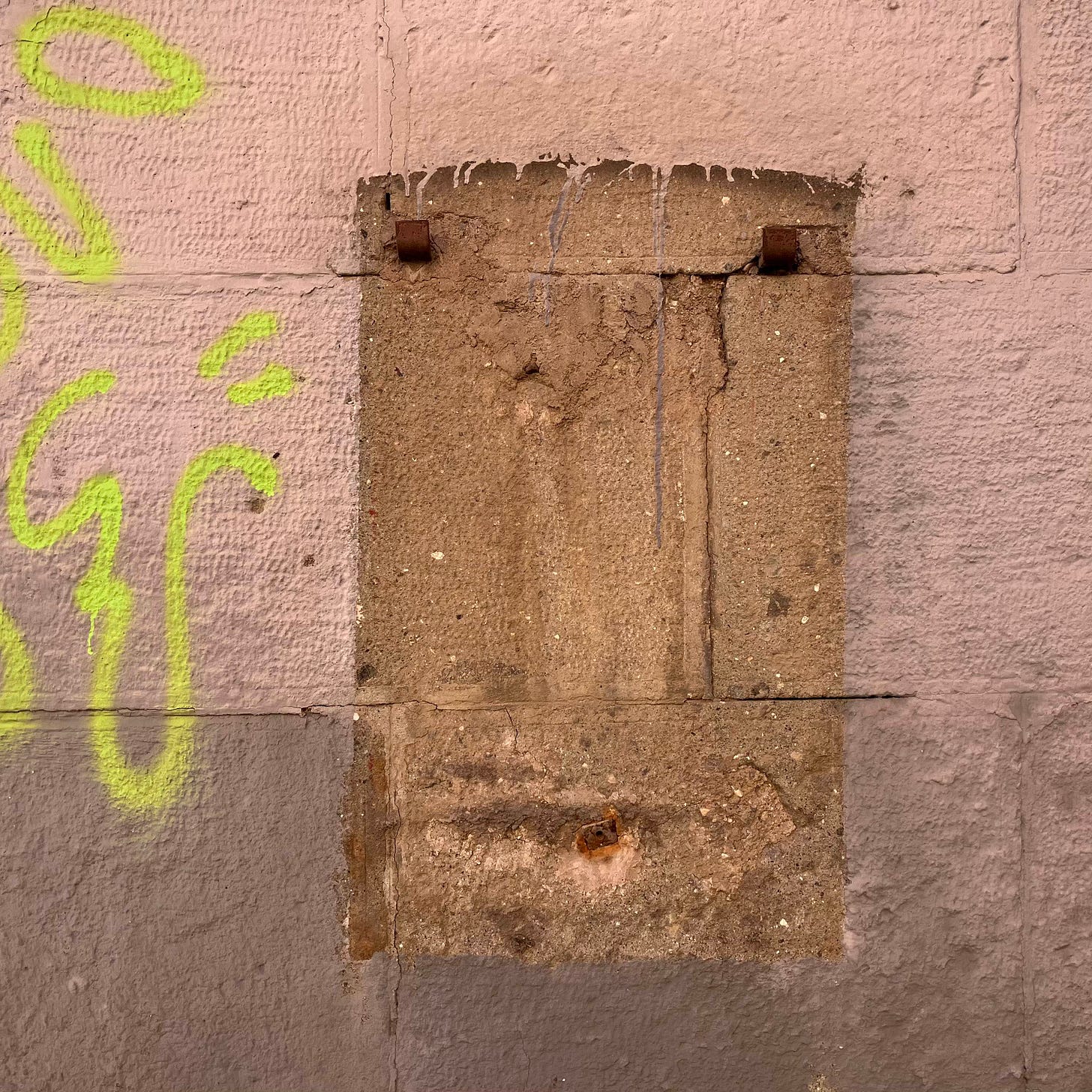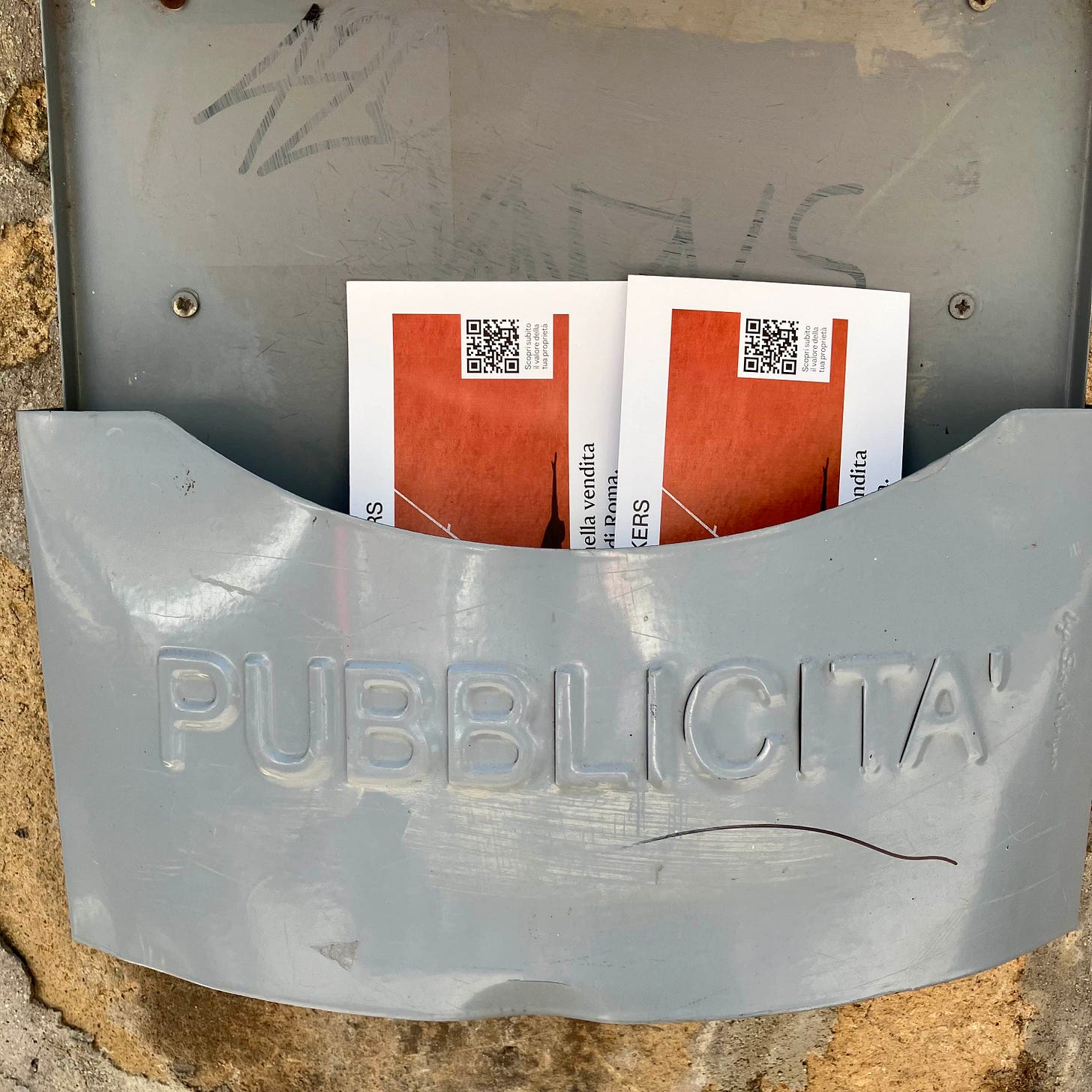No Junk Mail, Please. We're Italian.
In Rome, mail carriers zip around on motorini and don't always ring twice -- or even once.
When I opened the gate to the atrium of my apartment building in Rome, after three months abroad, I instinctively braced for the sight of my mailbox – surely overstuffed, envelopes no longer able to be wedged through the slot, excess mail perhaps tossed onto a tiny wooden side table by exasperated mail carriers.
How silly of me.
Accustomed to wading through the unsolicited pitches from banks, cable companies, charities and politicians that fill my family mailbox in New York, I had momentarily forgotten how little mail people in Italy receive.
No need here when leaving for vacation to ask friends to stop by so that mail won’t pile up and signal to the ill-intentioned that occupants are away. Or engage a house-sitter to scoop up letters, bills, and, inevitably, mountains of junk mail.
My Rome mailbox, a spartan, rectangular affair of wooden sides, a transparent plastic front panel and the tiniest of keyholes, measures 4 inches wide by 15 inches high and 10 inches deep and hangs wedged between the mailboxes of my condominium neighbors. In my absence, some utility bills, a few bureaucratic notices but not one piece of junk mail patiently awaited my return.
Why so little mail in Italy?
Reasons are multiple, including a reputation – deserved or not – for the snail-like pace of snail-mail delivery. That in Rome the postino or postina (mailman or mailwoman) zips along on motorini (motor scooters) on their routes doesn’t seem to have any bearing on how fast or slow the mail takes to arrive.
A Poste Italiane motorscooter parked on a Rome street while mail is delivered.
Cherry red metal postal service collection boxes, long affixed to outside walls of buildings scattered throughout neighborhoods, always caught my eye. But in a couple of decades of living in my neighborhood, only once did I spy a person slipping a letter through the slot of the mailbox a block from me.
“Act of faith,” I said to myself.
“Faith rewarded,” I thought the rare times I glimpsed a postal worker removing the contents of that mailbox.
I walked down the block to take a photo of that mailbox for this piece. I discovered the red mailbox was no more. In its place remained two rusting hooks and a shade of darker paint on the wall to mark the spot where it had hung been for years.
The “ghost” shadow left where for years hung a red public mailbox on a street in Rome.
According to a 2023 news release from Poste Italiane, the Italian post office company, the iconic red boxes are being removed to be replaced with “smart” boxes which will indicate to postal collectors how much mail is inside.
Are letters being so infrequently deposited in street mailboxes that collectors need an electronic reader to alert them when correspondence is inside?
Mailing birthday or get-well cards or Mother’s Day greetings has never caught on here. Personal contact is paramount in Italy. Why mail well-wishes when you can give the well-wished a hug? Italians tend not to move far from home. So momma is often a stroll away.
As for mailing checks – perish the thought!
Perish the thought is exactly what I did when I moved to Italy and asked why Italians spent hours waiting in banks or post offices to pay utility or tax bills. Why not write a check, paste a stamp on an envelope and send it on its merry way in one of those cheerily-painted red mailboxes?
I came across as the Naïve and Trusting American. Putting a check in the mail is like inviting a thief to cash it, Italian reasoning goes.
And, anyway, what guarantee payment arrives before due date?
How silly of me.
Of course, with online banking and bill paying, Italians don’t need to go any more to the post office to submit payment.
But to the post office they still go.
Poste Italiane doubles for many in Italy as a kind of bank. Mounted outside post office branches are Postamats, like ATMs outside of banks. In all, some 8,500 Postamat machines are scattered throughout Italy.
Inside, Poste Italiane clients can chat with financial advisers about opening up investment instruments. According to 2024 figures from Poste Italiane, 6.5 million people – that’s more than 10% of Italy’s population -- have Poste Italiane “bank” accounts.
In some remote places, like the tiny Italian isle of Linosa, there is no bank, but there is a post office. Locals or visitors there can withdraw cash from their savings accounts at Poste Italiane, a publicly traded company, which has as one of its major shareholders the Italian finance ministry.
As for junk mail, Romans have devised a system to both discourage and accommodate it – a kind of classic compromise all’italiana.
Junk mail here is really a kind of misnomer, since it infrequently arrives by mail. Instead it’s called “pubblicita’” – advertisements – and arrives thanks to low-paid college students or immigrant gig workers trudging door-to-door to stuff the material into occupants’ mailboxes.
Weary of advertisement carriers ringing the names on intercom panels in hopes someone will buzz them inside, condominiums have attached outside their front door metal receptables, some of them vaguely resembling fireplace log holders. Junk mail gets deposited there, for residents to take or not.
Some Rome apartment buildings put receptacles outside so junk mail deliverers don’t ring.
So, then, what DOES wind up in one’s mailbox in Rome?
A “raccomandata” is a letter which sounds to innocent ears like something nice – who wouldn’t welcome some recommendations? But a “raccomandata” often conveys unwelcome news -- like a fine for running a red light or a notice of tax due.
To receive a “raccomandata,” the addressee must sign for it.
More than once, I have found in my mailbox the dreaded yellow postal card indicating that I had “missed” the delivery of a “raccomandata.” But the delivery time scrawled on the card by the postina/postino often turned out to be a time when I was home. Missing a “raccomandata” necessitates a trip to receive it at a post office – not always the one closest to home.
Instead of another remake of that classic film noir “The Postman Always Rings Twice,” perhaps there’s fodder for a Roman sequel that could be titled “The Postman Never Rings Even Once.”







I have an article coming about Poste Italiane in a few weeks :) I’ll share with you!
Some experiences are universal, I guess.
I had the same response you did, about paying bills by check when I first moved to Rome. Now, when I'm in the states, I see people pulling out their checkbooks and it feels so retro!
And the end: like you, I've received notice of a package or a raccomandata while I was home, though the yellow cards now seem to have disappeared in favor of a notice printed on thermal paper.
I love your photo of the wall where the mailbox once hung. It seems so symbolic.